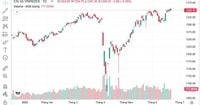The Vietnamese stock market has been navigating a complex landscape in late June 2025, characterized by cautious optimism, sector rotation, and geopolitical tensions that have kept investors on their toes. After a week marked by a notable rebound and strong sector performances, the VN-Index closed at 1,349.35 points on June 20, reflecting a 2.57% increase from the previous week but also signaling a market that is consolidating and awaiting clearer direction.
The week starting June 16 was marked by heightened attention to escalating conflicts between Iran and Israel, which injected a degree of uncertainty into global financial markets. Despite this, the VN-Index managed to regain key technical levels, specifically the MA10 and MA20 moving averages, and even stepped back into the territory of its previous peak. This comeback was the most robust in two months, showing resilience amid external pressures.
However, the days following this initial surge were relatively subdued. The index fluctuated narrowly around the 1,350-point mark, with a noticeable decline in liquidity—a key ingredient for sustaining upward momentum. The final trading day of the week, June 20, saw ETF portfolio rebalancing, which had only a minimal impact on the broader market, allowing the VN-Index to maintain its position.
Despite the positive weekly gain, experts caution that the market has yet to break out decisively. According to a market report from the securities firm CSI, the VN-Index is likely to continue its accumulation phase, characterized by alternating increases and decreases, before it can mount a stronger upward push. The report recommends investors hold their current positions and consider augmenting their portfolios selectively during market fluctuations, particularly in stocks already showing profits.
Underlying this cautious optimism is a shift in the flow of capital within the market. Early in the week, the rally was driven by Vingroup stocks, a heavyweight in the market, but soon after, investors redirected their attention and funds toward mid-cap and large-cap stocks. This rotation indicates a market sentiment that is actively seeking new opportunities beyond the usual blue-chip leaders.
As the market approaches the end of June, sectors such as banking, real estate, and energy are expected to remain in the spotlight. These sectors not only have strong fundamentals but are also positioned to benefit from macroeconomic policies and legislative changes. For instance, the residential real estate sector has seen a significant boost, buoyed by expectations of relaxed bond issuance policies following the National Assembly's approval of the revised Enterprise Law. Stocks like KDH and HDG, which have solid fundamentals yet remain undervalued, are attracting investor interest.
Export-oriented stocks are also gaining attention, particularly in areas where Vietnam holds competitive advantages. Textile companies like MSH and TNG, natural stone producer VCS, and seafood firms such as VHC and ANV could benefit from anticipated positive outcomes in ongoing US tariff negotiations. These developments could open new avenues for growth amid the broader market's consolidation.
Nevertheless, liquidity remains a critical concern. The past week's trading volumes were consistently below the 10-session average, signaling that while demand exists, it is not yet strong enough to fuel a sustained rally. Technical indicators also point to a slowing momentum. The VN-Index’s return to the 1,350-point region was accompanied by negative divergence signals on the RSI (14), suggesting that the upward push is losing steam. After surpassing 1,340 points, the index stalled with three consecutive sessions of sideways movement within a narrow ±5 point range, a pattern that may indicate short-term distribution by investors.
Looking ahead, the next one to two trading sessions will be crucial in determining the short-term trend. Unless there is a breakthrough in the US tariff negotiations, the VN-Index is expected to continue oscillating between the 1,300 and 1,350 points range in the coming weeks. The 1,300-point level remains a reliable support base, while 1,350 points continues to serve as a significant resistance zone.
Given this environment, investors are advised to adopt a defensive yet flexible strategy. Maintaining a balanced stock allocation and avoiding chasing prices near the peak can help mitigate risks. It is prudent to focus on stocks with clear cash flow, strong fundamentals, or those positioned to benefit from favorable policies. Moreover, stocks with unique growth stories that can sustain momentum independent of the general market trend present attractive opportunities.
Foreign investor activity during this period was relatively subdued but noteworthy. They net sold approximately 200 billion VND overall, with significant purchases in HPG (+640 billion VND), NVL (+343 billion VND), and VPB (+227 billion VND). Conversely, they reduced holdings in VIC (-983 billion VND), VHM (-523 billion VND), and STB (-378 billion VND). This selective buying and selling pattern underscores the nuanced approach foreign investors are taking amid the current market conditions.
From a technical perspective, the VN-Index remains above key moving averages—MA20, MA50, and MA100 on the weekly chart—indicating that the mid-term uptrend is intact. The weekly candlestick pattern, featuring a lower shadow, suggests some selling pressure emerged toward the end of the week but was insufficient to reverse the upward trajectory. Yet, the momentum is clearly slowing as the index approaches the upper Bollinger Band, signaling that the market is in a phase of peak accumulation and awaiting fresh impetus, possibly from renewed cash inflows or positive news.
In summary, the Vietnamese stock market is at a pivotal juncture. The resilience shown in recent weeks, despite geopolitical uncertainties and liquidity challenges, paints a picture of a market consolidating its gains and preparing for the next move. Investors would do well to stay alert, balancing caution with selective opportunities, especially in sectors poised for growth due to policy support or competitive advantages. The coming weeks will likely reveal whether this consolidation will culminate in a breakout or a deeper correction, but for now, the market's pulse beats steadily within a well-defined range.

